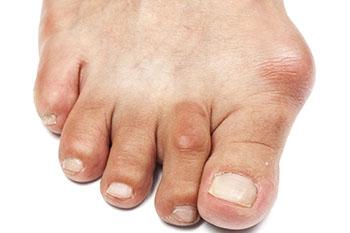Dallas Metro / North Texas
(214) 710-1028
Bunions

A bunion is a progressive foot disorder commonly recognized as a bump on the side of the big toe called the hallux. The hallux is drifting towards the second toe while the first metatarsal is protruding the opposite way. There is a gradual progressive increase in the angle between the first and second metatarsals. It can also be described also as a progressive dislocation of the joint between the first metatarsal and the medial cuneiform that results in the hallux to lean towards the second toe causing deformity at the big toe joint. Bunions do not always cause pain especially at its early stages. However, as the bunion gains more prominence and gets progressively larger, it is not uncommon to experience pain at the characteristic bump site or within the big toe joint.
Bunions are caused by an innate faulty biomechanical structure that affects how the bones and joints of the foot operate. It is not the bunion itself that is inherited, but the certain foot types that is expressed in form and function that make a person prone to developing a bunion.
Shoes do not cause bunions but do exacerbate a progressively occurring bunion. Wearing shoes that have a tight toe box or high heels can facilitate the worsening of a bunion deformity causing symptoms to develop or worsen. Spending prolonged periods of time on the feet can also result in a symptomatic bunion experiencing pain, soreness, redness, inflammation, burning sensation, and even numbness at the site of the deformity. A bursa or a fluid filled sac that develops over the bony prominence of the bunion in response to chronic irritation may also become inflamed with painful symptoms. Those with bunions may also present with associated conditions such as a hammertoe or crossover toe of the second toe. This occurs when the constant pressure of the big toe during weight-bearing causes the second toe to eventually elevate weakening and deforming the soft tissue structures that stabilize the second toe joint. A callus or corn formation at skin beneath the second toe joint may occur.
Although a bunion is readily apparent upon physical examination, the foot and ankle surgeon will need to get x-rays to evaluate the extent of the misalignment of relevant bones and joints. This information is also used for surgical planning.
Early treatment options include changes in shoe wear, padding, activity modification, medications (NSAIDs), icing, injection therapy, or orthotic devices. Orthotics realign the foot and may delay progression of the bunion. When pain from the bunion becomes disruptive, then surgical options are available. Advances in surgical technique have led to a high success rate in bunion corrections. The foot and ankle surgeon will discuss in detail the decision making behind procedure selection and goals of surgery.
Another condition similar to the bunion is the bunionette or tailors bunion. Everything described about the bunion applies to the bunionette except for the anatomy. Bunionette is a bump located at the side of the little toe. The fifth toe drifts towards the fourth toe while the fifth metatarsal is protruding the opposite way.




